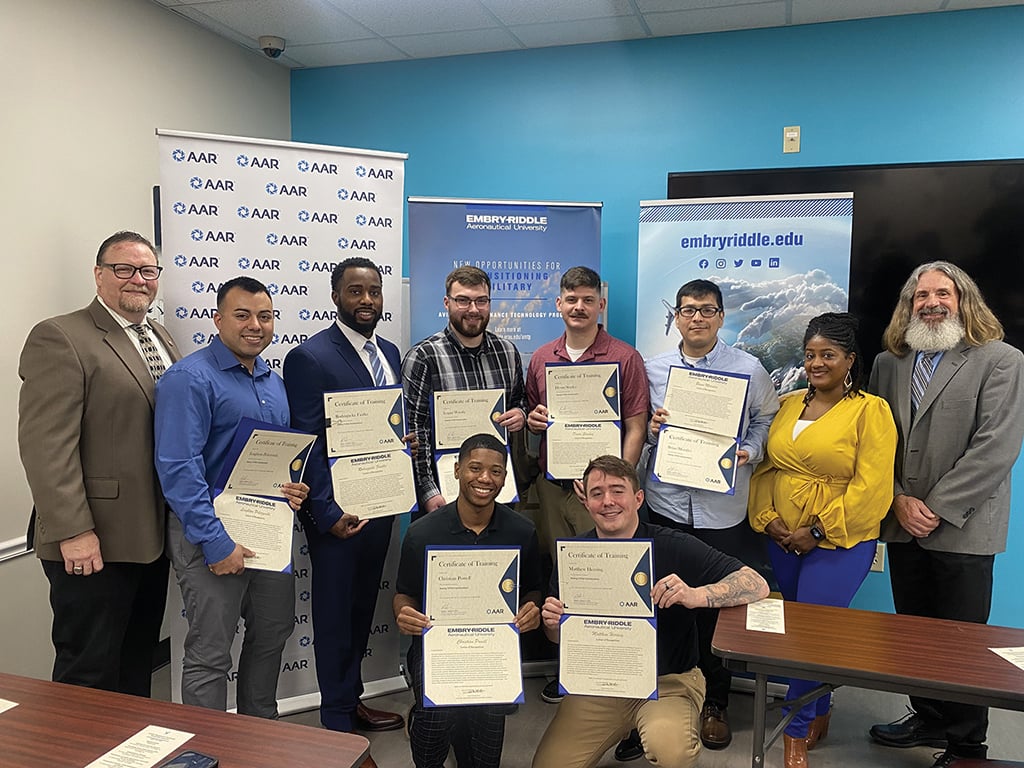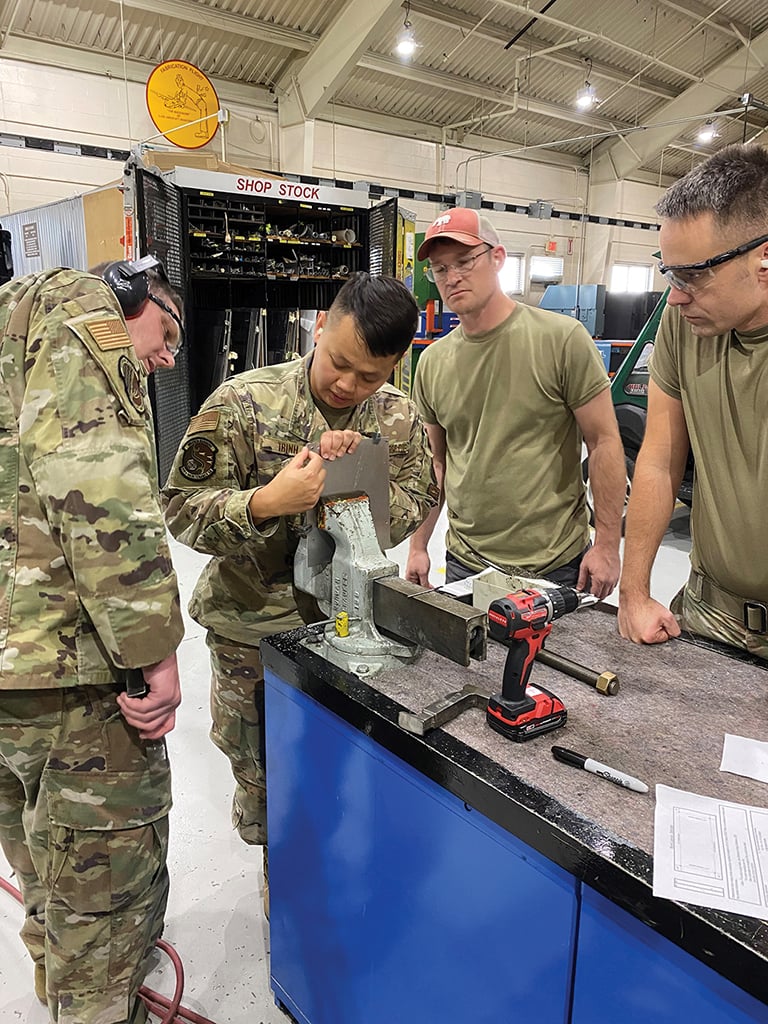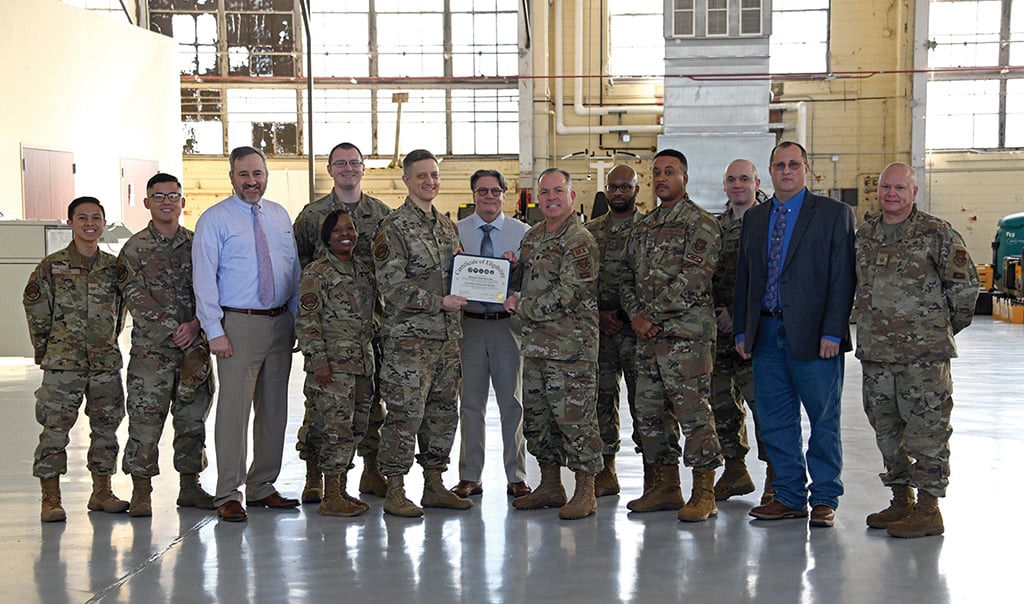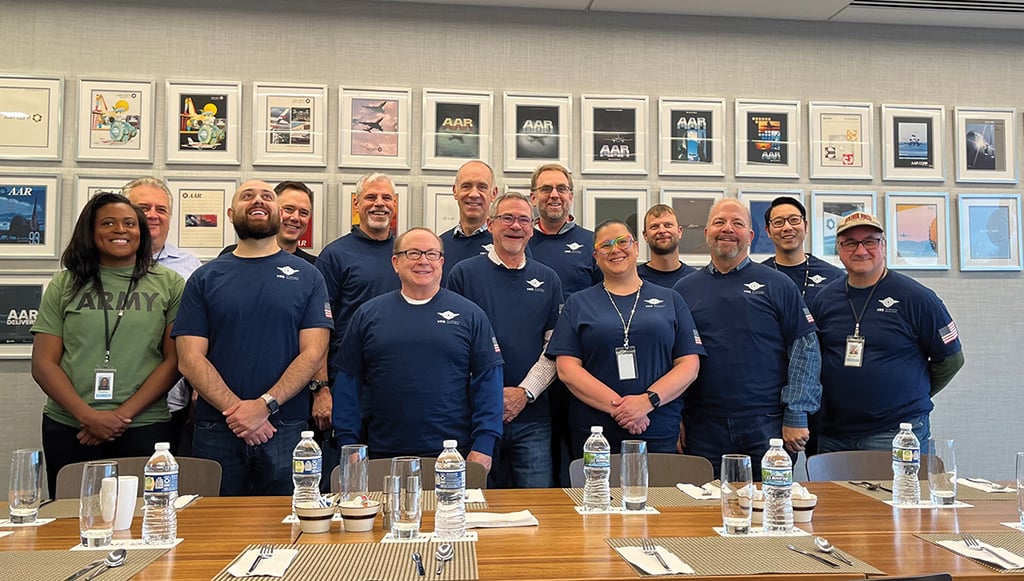
Veterans with aviation maintenance experience are often faced with confusing guidance about the steps required to qualify and test for A&P certification.
More than 20 new MRO facilities opened around the world in 2022, and growth looks poised to continue this year. More new hangars and expansions are driving increased hiring as companies announce plans to recruit hundreds of new technicians.
This market growth is not unexpected. Aviation Week Network’s 2023 Fleet and MRO Forecast indicates that global MRO demand will grow to $112.6 billion in 2032 from $87.6 billion this year. The U.S. Bureau of Labor Statistics projects about 13,100 openings for aircraft and avionics equipment mechanics and technicians each year over the next decade. Boeing forecasts that the industry will need 610,000 new maintenance technicians through 2041.
However, achieving these lofty workforce goals is likely to be difficult. The MRO industry was already talking circles around the workforce shortage pre-pandemic, and during COVID-19 it lost significant talent to early retirements, layoffs and the departure of qualified workers leaving for industries perceived to be more stable or lucrative. The Aviation Technician Education Council (ATEC) predicts that the mechanic pipeline in the U.S. will need to ramp up by at least 20% to meet projected workforce demand.
The industry is brimming with efforts to recruit new talent from previously untapped pools, including initiatives to attract women to MRO work and to reach younger students while they are still thinking about careers. One potential talent pool that has always appealed to the aviation industry is the military, and efforts to target service members who want to transition to the civilian workforce are now cranking into overdrive.
MRO provider Constant Aviation’s website highlights a $15,000 signing bonus for veterans in big, bold letters. Three of American Airlines’ regional subsidiaries—Envoy Air, Piedmont Airlines and PSA Airlines—are advertising five-figure perks packages for veterans to lure qualified maintenance talent. Envoy recently relaunched its Military Transition Program due to high demand for MRO workers, with a manager of maintenance recruitment telling Aviation Week it is looking for approximately 75 new technicians per month across the U.S. Several MROs and technical schools that just won six-figure aviation maintenance workforce development grants from the FAA have pledged to put some of the funding toward improving military transition efforts. And every day, more airlines and MROs are launching initiatives to attract military talent.
Mike Reporto, chief commercial officer at MRO industry staffing specialist Launch Technical Workforce Solutions, says that demand for veterans is extremely high. “There’s not a customer that has turned away the opportunity to hire a vet,” he says. “We’re seeing a big change post-COVID-19 and demand is through the roof right now. There’s not enough talent to go around,” he adds.
Military talent is particularly enticing to aviation companies, not only due to hands-on experience working with aircraft but also for what Reporto refers to as “the intangibles and soft skills.” Every industry source interviewed for this article raved about the skill sets of veterans.
“A lot of the things the military teaches really translate well into the aviation industry. We’re talking about standards, processes, being on time and doing mission-oriented type work—that is very much also a part of the commercial aviation industry,” says Angela Albritton, director of military relations and strategic initiatives at Embry-Riddle Aeronautical University.
“Veterans tend to display a strong work ethic, come equipped to handle stressful situations and are team-oriented and disciplined. Because of their inherent leadership skills, we often quickly consider them for promotional opportunities,” says Clarissa Carl, director of talent acquisition at HAECO Americas.
“I like to say that we know our veterans show up. They’re passionate about the work they do and they show up every day ready to do their job to the best of their ability,” says Jennifer Murphy, talent acquisition leader at GE Aerospace. “Especially when you look at building the future of flight, we work on a lot of different products that affect the military. Our service members have already done that work while they were in the service that directly correlates to the work that they’re doing within GE Aerospace now. It’s just a continuation of their service.”

As a result of this high demand for veteran talent, Reporto says many of the airlines, MROs and OEMs Launch works with are starting to network with military bases and explore opportunities for military transition programs, such as the Defense Department’s SkillBridge program. The program works to connect service members with companies in various industries during their last 180 days of service for on-the-job training (OJT), apprenticeships or internships. The Defense Department continues to pay the service member’s salary and benefits throughout the program. Since its launch more than a decade ago, SkillBridge has grown significantly, and now many organizations operate as Pentagon-approved third-party providers for the program.
One such provider is Embry-Riddle, which launched its MRO-focused Aviation Maintenance Technology (AMT) Program for Transitioning Military in 2019 after success building an IT-focused SkillBridge program. It launched its first AMT SkillBridge cohort at Marine Corps Base Camp Lejeune and quickly expanded to a total of six military base locations. Embry-Riddle also offers a virtual SkillBridge version, enabling service members stationed at other bases to participate.
“The beauty of the program is they don’t need to have an aviation maintenance MOS [military occupational specialty] or rating. If they have a mechanical aptitude and want to join the aviation maintenance industry, they can go through the program,” Albritton says.
Completing the nine-week program earns participants an 18-credit-hour aviation maintenance certificate from Embry-Riddle. Participants can also obtain a Boeing 737 familiarization certificate through working with MRO partner organization AAR. Embry-Riddle works with a group of industry partners, including airlines, MROs and OEMs, to connect participants with job opportunities, as well as to help service members with resume-writing and interview skills. Albritton says Embry-Riddle’s goal is for 100% of participants to receive job interviews by the end of the nine-week period.
Embry-Riddle’s latest cohort of 69 service members just graduated in March, bringing the program to a total of 452 graduates. More than 97% of program participants have had interviews and more than 85% have received offers of employment, with that number expected to increase once the most recent graduates begin transitioning. Albritton notes that some participants opt out of interviewing with Embry-Riddle’s industry partners because they want to move to a city where those companies do not have work locations.
Albritton says that motivating transitioning service members to consider new geographic locations is a key challenge it has encountered during the program. “We’re working hard to try to get them to understand that to build your career, especially coming out as junior enlisted, might mean that you’re going to have to move a few times. There are not necessarily always aviation maintenance opportunities in certain areas where you want to settle,” she says.
On the contract labor side, Reporto says veterans, unlike typical contractors, are not used to relocating for different job opportunities. “Veterans are used to having roots and having a home,” he says. “They resort to going home post-transition, and it’s very challenging for them to then leave their families when they’ve been gone for so long, to relocate and start a career. Typically, they look to start careers in their hometown, which limits opportunities,” he adds.
One company tackling this challenge head-on is AAR, which has managed to build a large workforce in Indianapolis by relying on veterans. Ryan Goertzen, AAR’s vice president of workforce development, says the company’s Indianapolis facility was previously low on new recruits’ list of location choices compared to cities like Miami, but the rising cost of living and a coordinated effort by its Indianapolis human resources (HR) department has now created an unofficial home base for much of its workforce of veterans.
“There are more veterans [in Indianapolis] than [on] any of our other bases, so there’s this family that’s kind of been set up,” Goertzen says. “Many of these veterans are on an island when they leave the military and go to a place where they’ve never been before. To create that kind of hometown feel and environment where [veterans] are not on their own, our HR department does an incredibly good job.” These efforts range from helping veterans find housing to something as simple as driving a veteran without an established personal network to the doctor when they are sick. AAR also runs a Veteran Resource Group that performs outreach and holds internal events, such as a recent event recognizing AAR employees who were working in Afghanistan during the recent withdrawal of the U.S. Embassy staff.
Despite efforts to make veterans feel at home, some report that location constraints as well as financial considerations remain a significant challenge. Douglas Friedlund, a transitioning helicopter mechanic with 20 years of Air Force experience, has had a smooth process entering the civilian workforce, but he has seen firsthand some of the barriers veterans face.
“It doesn’t help that lucrative civil aviation work tends to be focused either in dense urban areas with high costs of living or extremely rural areas without major infrastructure. In either case, very few aviation companies seem willing to offer relocation assistance,” Friedlund says.
As an example, he says a service member he had been deployed with had no maintenance experience but wanted to work with airlines after his service. The service member attended a Part 147 school using his GI Bill entitlement and was initially placed with a feeder airline in a major city making $28 an hour, before later being hired by a legacy carrier at more than twice the pay. “He made [that wage in a major city] work because he had a passion and a goal, but I don’t think your average service member would find that to be a compelling career move in the current labor market,” Friedlund says.
Beyond work locations and pay levels serving as potential hurdles to the MRO industry’s attempts to attract veterans, other industries are also poaching talent. Reporto says Launch is seeing veterans leave aerospace for opportunities in industries such as oil and gas, which can pay more competitive starting wages.
“When the industry is looking at hiring people from the military, there are now so many nontraditional competitors. It’s not just the defense industry, but also nontraditional competitors like the IT industry,” Albritton says. “We want to make sure the industry stays in step with what others that are looking for veteran talent are paying, and make sure our industry stays competitive with that.”
“Competition with defense contractors is a huge obstacle,” Friedlund adds. “Service members may be disinclined to break into the civil industry because military contract work is plentiful, requires no certification in most cases, doesn’t require mechanics to purchase their tools and keeps them in their comfort zone.”

A disconnect between military and civil aviation experience is also a major hurdle. “Older service members in particular seem to have an easier time securing management and leadership positions with government contractors, whereas they may have to restart at the bottom in the commercial sector,” Friedlund explains.
One veteran who now leads the Kansas City, Missouri, airframe MRO operations for ATS can attest to the upward growth potential in the industry, but it was not always easy. Jeremy Stamper started in a Mechanic 1 position and worked his way up to maintenance supervisor in three years at ATS, but he struggled to find common ground with companies he had previously interviewed with.
“One of the challenges that I faced personally when doing interviews was that a lot of people aren’t really sure how much military experience applies or can transfer. If you have five years’ experience commercial and five years’ experience military, unfortunately a lot of times people will look at commercial as a lot more valuable, so thankfully that wasn’t the case when I came to ATS,” Stamper says.
At GE Aerospace, which began SkillBridge efforts in 2021, veterans are actively part of the recruiting process. “Whenever we’re interviewing somebody we know is a service member or transitioning veteran, we try to have a veteran on the interview panel because they speak the same language. [Both industries] have a lot of acronyms, so how do we bridge that gap so everyone is speaking the same language?” Murphy says. “Our veterans struggle sometimes with correlating what they did in the military to how that works in whatever role they’re interviewing for, so we try to help them with that.”
In addition to leveraging its sizable workforce of veterans to help place candidates where they might fit best, GE’s Aerospace Veterans Network pairs new employees with a special veteran mentor to help coach them along their path at the company. It has also formed a Veterans Advocacy Council that helps educate senior leadership on both military skill sets and negative stigmas about veterans that could hinder their progress in the industry.
“It’s one thing to get [veterans] into one of our multiple pipelines and in the door, but it’s also a challenge to retain that talent,” stresses Marcel Alvarez, co-leader of the GE Aerospace Veterans Network. “The stats are staggering with how many veterans will go to a company, get their first job and decide, ‘I don’t like this,’ then go to another company, job, function or industry. There’s a retainment component that’s probably more critical than just hiring.”
Launch practices similar strategies, such as its Working Heroes program, which uses a recruiting team comprised of veterans and partners with military organizations and Part 147 schools to create pathways for veterans to transition to civilian MRO. Since its launch in 2013, more than 2,000 veterans have been hired through the program.
Reporto says Launch is very selective about the companies it partners with on the program, insisting that they must be able to provide OJT and mentorship. “What we cannot do is just place a veteran into a civilian position and expect them to understand the ins and outs of working in a civilian maintenance hangar,” he says. When companies try to fit a square peg into a round hole, so to speak, Reporto says attrition is much more common.
“It’s not that [veterans] don’t know how to do the job—it’s just different jargon, different materials and different airframes,” he says. Through the program’s OJT and mentorship, it features specific milestones and a built-in pay progression scale based on how new hires are performing against expectations. Where some companies go wrong, he notes, is when “they’re looking to fill a job with minimal training and time to transition. They want them to jump in and turn wrenches right away. But if there’s an investment up front, the return is unmatched with hiring a veteran.”
One company working to bridge the gap between the military and commercial aviation is SkyBridge, a Pentagon-approved third-party provider focused on helping veterans transition. According to Austin Roth, founder and president of SkyBridge, there are several areas of disconnect making the process difficult for veterans interested in aviation maintenance careers.
“Prior to getting hired, even outside of aviation, resumes are a big thing—they don’t speak civilian very well sometimes,” he says. “If you say, ‘I was a senior E-7,’ that doesn’t mean anything to somebody [who] wasn’t in the military, so we’re going to change [the job title] to senior maintenance manager. The terminology matters,” Roth explains.
Even details about benefits after hiring can prove complicated for a veteran. “A 401(k) is not something that we’re used to dealing with in the military. Health savings accounts and [other benefits package features] can be a little overwhelming because usually those decisions are kind of made for those of us that are in the military,” says Roth. “[In civilian life] you have to opt into or out of certain things.”
Beyond the struggle to adjust to commercial aviation, perhaps the biggest obstacle for veterans entering the commercial MRO industry is the need to obtain an airframe and powerplant (A&P) license.

“In theory, the A&P should be the easiest nut to crack, but it continues to be a huge barrier for some reason,” Friedlund says. He notes that most military mechanics accrue enough experience to qualify for A&P certification and that there are many courses designed to help military mechanics pass the test regardless of their experience with civil aviation.
“I can only assume that a lot of military mechanics are intimidated by so much of the A&P test being focused on subject matter that they have no exposure to, such as piston engines, fabric coverings and civil regulations,” says Friedlund. “The real tragedy is that the competencies needed to maintain a modern military aircraft are closely aligned with those needed to maintain a modern business or commercial jet, but the antiquated A&P certification program does not reflect that. The new Airman Certification Standards are a step in the right direction, but they still fall well short of where the industry and military are today.”
One issue is the lack of knowledge about licensing, or confusion about programs and testing, particularly given the sheer volume of transition programs that have developed over the last decade.
“The A&P license is definitely something I wish more veterans knew about before they got out,” says Stamper, noting that some bases—such as those working directly with the companies and schools mentioned in this article—offer clear guidance about the steps required to qualify and test for certification. However, after attending an A&P school he was dismayed to realize that much of the maintenance work he was already experienced with was not covered in A&P written exams. “If you go in with just work knowledge, you are not going to be prepared to take that test for that license,” he adds.
“I think there’s a really big gap that exists right now and it’s very difficult for maintenance technicians to transition in comparison to their pilot counterparts,” Goertzen says. He argues that the industry needs to lobby for the creation of a competency process that makes it easier for veterans to obtain FAA certification.
ATEC, which estimates the civil aviation industry is capturing less than 10% of exiting military veterans with maintenance experience, is actively pursuing this. The organization recently submitted a letter to Congress calling for policy reforms that would better support transitions between military and civil aviation for veterans with maintenance experience. ATEC has requested, as part of the upcoming FAA reauthorization process, that the government work to increase awareness of the process and to harmonize Part 65 aviation maintenance certification requirements with Part 61 requirements for military pilots. It is calling for the design and implementation of a military-competency aviation maintenance technician testing process that would allow current and former aviation maintainers from the U.S. Armed Forces to apply for and receive an FAA-issued A&P certificate.
This is not to say that there are not already options. In addition to myriad SkillBridge programs in the industry, ATS has several “fast-track” programs in place, and Launch works with the Aviation Institute of Maintenance and Code 1 Maintenance to help veterans obtain their A&P licenses prior to entering the industry. However, Friedlund notes that only a small portion of the companies he has spoken to during his transition process were even aware of SkillBridge.

Within the Defense Department, the Joint Service Aviation Maintenance Technician Certification Council (Jsamtcc) program was established more than 20 years ago to enable military aviation maintenance technicians to earn their A&P certificate. Through the Jsamtcc program, service members can participate in a self-paced online program hosted by the Community College of the Air Force that enables them to take their written A&P exams before going on to take oral and practical exams with an FAA Designated Maintenance Examiner. However, the process still retains a certain level of complication, particularly since A&P testing sites may be located off base and require travel.
The U.S. Air Force’s 908th Airlift Wing recently launched the service branch’s first in-house A&P certificate program, through which eligible maintainers in the 908th Maintenance Group can train, test and obtain FAA A&P certification without traveling off base to the nearest testing site. The program is self-paced, building off the Jsamtcc program with in-house training taught by the 908th’s own FAA-certified mechanics at no cost to participants.
The program recently received FAA validation and its first two participants completed the program in January, receiving their A&P certifications. A representative for the 908th Airlift Wing says feedback has been “overwhelmingly positive” and several other Department of the Air Force installations are now looking into replicating the program.
Considering the growing number of options for veterans to obtain A&P licenses, SkyBridge’s Roth suggests the problem is more of a perception issue than a practical issue. For instance, he points out that a military maintainer could have an A&P certification paid for by the GI Bill in a relatively short period of time compared to military pilots needing to spend five months to a year getting all of the required ratings. However, he argues that the pilot community has developed a robust networking environment, so they can “find somebody or a group of people who have done what they want to do. It’s like they get all the answers to the test,” he says. “It seems like on the maintainer side, the networking piece is the part that’s missing.”
Roth argues that the MRO industry needs to do a better job marketing its careers to maintainers coming out of the military. “The pilots all know they’re in demand because CNN keeps telling them, but sometimes the maintainers don’t, and you’ll find them doing things outside of maintenance because they don’t realize how big of a commodity they are,” he says.
GE’s Murphy notes that unconscious biases about veterans in civilian industries can also hinder the process. “Not every single veteran is out in a war with boots on the ground,” she says. “There are many veterans that have done many jobs in their service, and understanding the work they’ve done and how it correlates to what your company does has been a game-changer for us.”
Alvarez adds to Murphy’s point, emphasizing that patience and long-term investment are key to veteran success in civilian industries. “I didn’t transition the day I took off the uniform and was handed a DD214 [Certificate of Release or Discharge from Active Duty]. It took me about 3-4 years to fully feel like I made a transition and wasn’t Capt. Alvarez anymore,” he says. “SkillBridge is the first step in that process. It puts a veteran in an environment where they can confirm or deny, ‘Yes, I can do this,’ and it builds a support network for them.”





